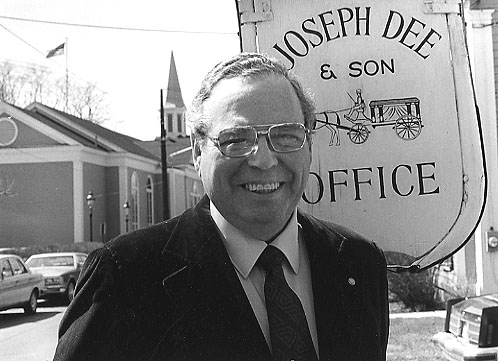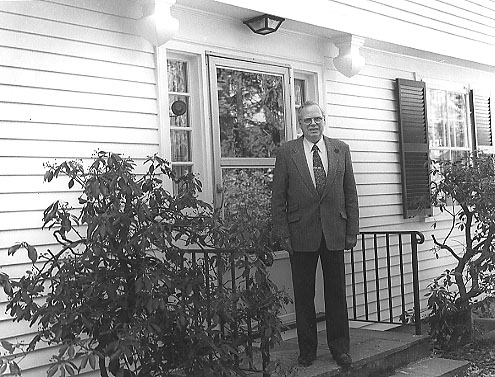Charles W. Dee, Sr.
37 Bedford Street
Interviewed May 12, 1982
Age 59
Concord Oral History Program
Renee Garrelick, Interviewer.
Click here for audio in .mp3 format
 The Undertaker
The Undertaker
Willard T. Farrar--The undertaker as cabinet maker
Development of the Dee Funeral business
Use of the town hearse
Mrs. Hosmer's funeral
Custom of tolling the bell
Burial Grounds Within Concord
Main Street, Old Hill, New Hill and Sleepy Hollow cemeteries
Grave of John Jack- Old Hill
Sleepy Hollow as America's "Westminster Abbey"
Smallpox Cemeteries
Catholic Cemetery
Prison Cemetery
My great grandfather Joseph Dee came from a farming community
in Waterford County, Ireland in 1860. He walked from Charlestown
to Lincoln and got a job at the Brooks Farm. He later moved with
my great grandmother Elizabeth to -the Fay Farm on Bedford Street
in the late 1860's. They came in a wagon with their five children
and possessions, cutting through Bronson Alcott's backyard because
Bedford Street was so low and boglike then.
I read in Thoreau's notations that he mentioned an Irish family
had bought the Fay farm. My great grandfather combined farming
with being a gravedigger at Sleepy Hollow cemetery. When my grand-
father later went to work for Willard T. Farrar, the local burial
agent, he accepted his offer to go into the business and succeeded
him when he died in 1910.
Willard T. Farrar was a cabinetmaker, which was a common
thing then since coffins were made to order at that time. The
funeral business grew because the undertaker was asked to do more
and more. People began to ask the undertaker to transport the
coffin to the church and then to the cemetery. The hearse in each
community was owned by the town, the way the firetruck is now.
There were two wagon hearses, the early plain one and the later
ornate one with six big plumes on top with heavy black drapes.
Our records start in 1868 when Mr. Farrar was appointed as
burial agent and for a time the town records and the Dee Funeral
Home records were one and the same. In 1936 as part of the WPA
project during the Depression, card files from the funeral home
were copied for the town.
In back of the First Parish Church there are a row of horse
stables and the stable with doors was the hearse house. This was
later moved to the first gate of Sleepy Hollow. School House
District #2, where my grandfather went to school became the cemetery's tool house and I remember the pot bellied stove inside.
My grandfather used it as a chapel with an organ inside and put
electricity in one of the rooms. We still have the beaver hats,
the coffin making bench and some of his brass edged tools. Younger
boys got paid $1.50 by Grandpa to stay with the body all night
and many of the Dee relatives were asked to do the same when
needed.
There was the custom of tolling the bell at the First Parish
Church when someone died - once for a male, twice for a female
and three times for a child, followed by the person's age.
I don't believe that the reason you can't find the grave-
stones of the earliest settlers is for fear that the Indians would
see their numbers diminishing. The colonists used wood for most
things and I believe this was true of the gravestones which decayed
and disappeared over time. They simply weren't replaced after
a while.
The first place in the springtime to be cleared of snow
and frost are the hillsides-and as I drive through New England
in the spring and see all those old hillside cemeteries I think
how smart those early settlers were.
Jethro's oak tree stood between the Main Street and Old Hill
Burying Grounds. There is the story that the reason for the two
cemeteries was because of the superstition of the early settlers
in carrying the deceased over a running body of water for fear
the soul would be lost. But I don't believe that. The people
from Nine Acre Corner buried their dead on Main Street and had
to carry the body over the Sudbury River.
The Main Street Burial Ground was also called for a time
Stratton's Cemetery after the first family buried there whose
first grave was in 1677. Joseph Meriam was the first to be buried
in the Old Hill Burying Ground in 1697, Anna Robbins was the first
to be buried in the New Hill Burying Ground in 1823 and Maria
Holbrook in 1859 was the first grave within the Sleepy Hollow
section. The Catholic Cemetery was purchased in 1863 and the first
burial there was in 1876.
There were small pox burial places on Fairhaven Road at the
junction of Route 2, in back of Colonel Barrett's Farm on Barretts
Mill Road, and on Main Street, in the backyard of the Hosmer
House where the overpass is. To curb a small pox epidemic which
the early settlers were so frightened of, the families would bury
the dead as soon as possible and burn their bedding and clothing.
The prison was a cemetery, though it is not used often and
numbers are used to mark those buried there. There are four
Civil War Veterans buried there. Some of the prisoners were
brought up from the Charlestown jail for burial there.
The reason for the location of the Old Hill Burying Ground
is because the First Parish Church was then located where the
stone house on Lexington Road is. Originally the First Parish's
budget was the town's. The grave most often visited there is
that of John Jack, the freed slave. A group of local lawyers
were responsible for erecting the tombstone, whose inscription
the Smithsonian Institute copied through a rubbing.
Sleepy Hollow was created from a receding glacial formation
called- an esker which left sandy pools of water. The natural
amphitheater was called Sleepy Hollow, when it was owned by the
Reuben Brown family and before Washington Irving's story by that
name was written. It was one of the areas that Emerson like to
go to meditate and it became the town cemetery in 1858.
The area between the New Hill Burying Ground and Sleepy
Hollow was an agricultural field acquired in 1869. Fairs were
held there, and a club house and cinder race track were included.
We find the remains of the track every so often today when a
grave is dug. Our forefathers in 1883 had the foresight to keep
the land adjacent to what once was the agricultural field in the
New Hill Burying Ground, open land forever.
To me Sleepy Hollow is America's Westminster Abbey, there
are so many world famous people buried there - Author's Row includes Henry David Thoreau, whose grave is the most frequently
asked for here, Ralph Waldo Emerson, Bronson and Louisa Alcott,
and Margaret Sydney. Thoreau's jailor, Sam Staples, is buried
nearby at the top of the hill. Ephraim Wales Bull who developed
the Concord Grape, Elizabeth Palmer Peabody, the founder of
kindergartens in America, and Daniel Chester French the sculptor
are buried here. His memorial to the three Melvin brothers from
Lowell Road,.killed in the Civil War, stands in Sleepy Hollow and
is called Mourning Victory. The statue is of a woman draped in
a flag with an olive branch in one hand and a dove draped on her
shoulder.
The corner posts of the Wheildon lot are made in the exact
shape of the Bunker Hill Monument, which he designed. The Hoar
family was an outstanding one in Concord that goes back to the
days of the Indians. The last speech to Congress that Senator
George Frisbee Hoar gave is inscribed on his tombstone. And
I was on the cemetery commission when the inscription on Anne
Rainsford French Bush's grave (1878-1962) was added - she was
the first woman licensed to drive an automobile in America.
In 1893 Sleepy Hollow was restricted to Concord residents.
Its maintenance is supervised by the town and members of the Dee
family no longer dig the graves.
Some of the early funerals were paid for by potatoes. No
veteran was ever denied burial because he was too poor. There are
still some of the table top tombs from the Civil War period,
made of sandstone which crumbles. My father James and Harold
Orendorff chartered all of the veteran's graves. Timbers from
the oak trees felled in the 1938 Hurricane form the cannon,
marking the lot of veterans from the Grand Army of the Republic.
The last time the town hearse was used was in March of 1970
when Gladys Hosmer died. She was an archivist and local historian
and it was her wish which we honored. The streets were lined
with people watching the hearse pass from the Episcopal Church to
Sleepy Hollow. And all you could hear was the clippety clop of
the horses hoofs while the bells tolled Mrs. Hosmer's age.
